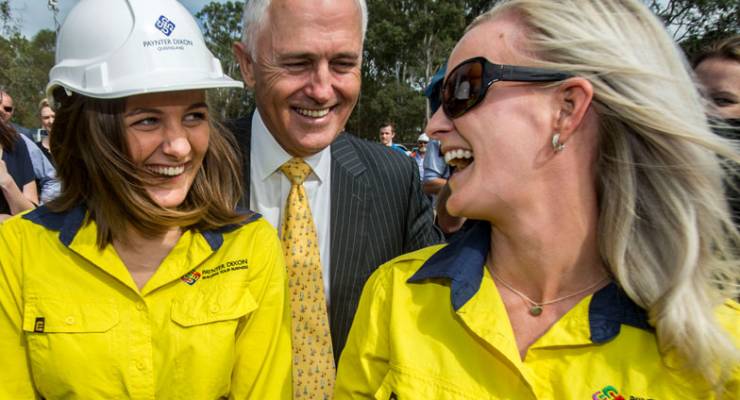
Infrastructure could have become Malcolm Turnbull’s legacy as Prime Minister. It could yet be — but last night’s budget does nothing to advance it.
So far, the signals from Turnbull on infrastructure are mixed: last week he unveiled a “Cities Plan” that was big on rhetoric but decidedly short on dollars. Monday brought the re-announcement of $5 billion in infrastructure funding from 2014, an apt recycling for the Asset Recycling Fund, an eminently sensible policy that provokes rage from Labor and reflexively anti-privatisation commentators on the apparent basis that government ownership of infrastructure is a sacred duty.
Under Turnbull, however, the Coalition has at least taken a significant step into the mid-20th century by accepting that the Commonwealth has a role to play in funding infrastructure where the greatest economic needs are — urban transport, especially public transport. And while it seems the Prime Minister has abandoned, or at least conveniently suspended, his enthusiasm for matters such as same-sex marriage, the republic and doing anything meaningful about climate change, he remains an enthusiastic, almost ostentatious, public transport devotee.
And things can’t really get much worse on infrastructure on his watch: under Tony Abbott, public infrastructure investment collapsed. At a time when the Reserve Bank and international institutions were calling for a steady “pipeline” of infrastructure projects to facilitate economic growth, spending in Australia was almost in freefall, while Turnbull got on with the task Abbott gave him in opposition of “demolishing” the NBN — something at which Turnbull turned out to be quite successful, given the dire state of what’s left of the NBN. Abbott also declared war on investment in renewables energy infrastructure, causing a collapse in private sector investment in what should not merely be an area of Australian competitive advantage but a crucial component in meeting even Australia’s laughably unambitious carbon emissions abatement targets. That war is now, at least for the moment, in abeyance, although Turnbull appears keener on playing pea-and-thimble tricks with renewables funding than increasing it.
Last night’s budget, however, disappointed on all fronts. The only new spending was $115 million for preparatory works at Badgerys Creek in Sydney and it actually cut $850 million from the Asset Recycling Fund and $160 million from the Infrastructure Investment Program via “efficiencies”. There’s much talk of “a record $50 billion in infrastructure investment”, but it’s all funding previously allocated under the Abbott government, albeit now made available for public transport funding. Or, in fact made available again — Labor in 2013 allocated $3 billion to the Melbourne Metro project, whereas this week the current government made much of re-allocating just $857 million to it after the Abbott government withdrew Labor’s funding.
Turnbull actually has a handy blueprint for greater, and more effective, infrastructure investment available to him. In February, Infrastructure Australia released a major reform document, the Australian Infrastructure Plan, which took on exactly the kind of issues facing a government that has little fiscal room for manoeuvre. IA urged greater borrowing for infrastructure (something that had been rumoured before the budget, but not borne out) and more privatisation, especially in power generation. More problematically, though, it also urged greater reliance on user charging as well. Turnbull himself launched the plan, but was noncommittal about its contents (the “Cities Plan” of last week barely scratches the surface of the IA recommendations). Many of IA’s policy proposals, of course, are matters for the states, not the Commonwealth, but given the government is happy to use additional education funding to in effect dictate reporting and recruitment requirements for state education systems, there’s no insurmountable hurdle to a greater Commonwealth role in state-level infrastructure policy.
Infrastructure offers exactly the kind of policy challenge that Turnbull should thrive on, combining smart government policy with innovative private sector funding, building and operation. Through it, he could achieve the kind of lasting economic legacy that would benefit the agile, innovative economy he’s always on about. But after last night’s effort, it seems we’ll be waiting a long time for genuine government re-engagement on the challenging of funding infrastructure, especially in our cities.








I’m not sure that it is sensible to asset recycle.
Inevitably you will run into the law of diminishing returns – the asset you sell won’t make as much as it cost to build, so the infrastructure you buy with that will be of lower value, and so forth.
And it is problematic selling assets that have a monopoly. Which infrastructure assets tend to have. Less problematic to sell things that have competition, such as Medicare.
So you think that the most important assets were built first and that making a private monopoly from them might not be so good?
But what about the donors to the Liberal party? Surely they should have a say?
I have a cities plan – don’t let Syd/Melb grow any bigger. Few cities even in cramped & crowded Euroland, apart from the capitals, are anywhere near to those two bursting wens.
Decentralise – cheaper land, cheaper housing, better lifestyle better environment etc, etc.
As for ‘Asset Recycling’, aka selling of the nation’s tax funded infrastructure to spivs, why wouldn’t Talcum think that a spiffing idea for his mates & ex-colleagues, as well as a bunch of comfy sinecures when he loses the election?
Decentralised population is good, but it is necessary to decentralise the jobs first.
From what I have read, Turnbull has revived the proposal to fund East-West link with $3 ‘notionally’ set aside for whichever side of politics in Victoria will build it. Very little for public transport in Melbourne, which is badly needed.
The migration and temporary entry programs should also be reduced in size as they are at historically high levels. We can still have a flow of people but without imposing the strains on major cities that the current levels of migration impose.
That should be $3 billion! $3 wouldn’t go very far.